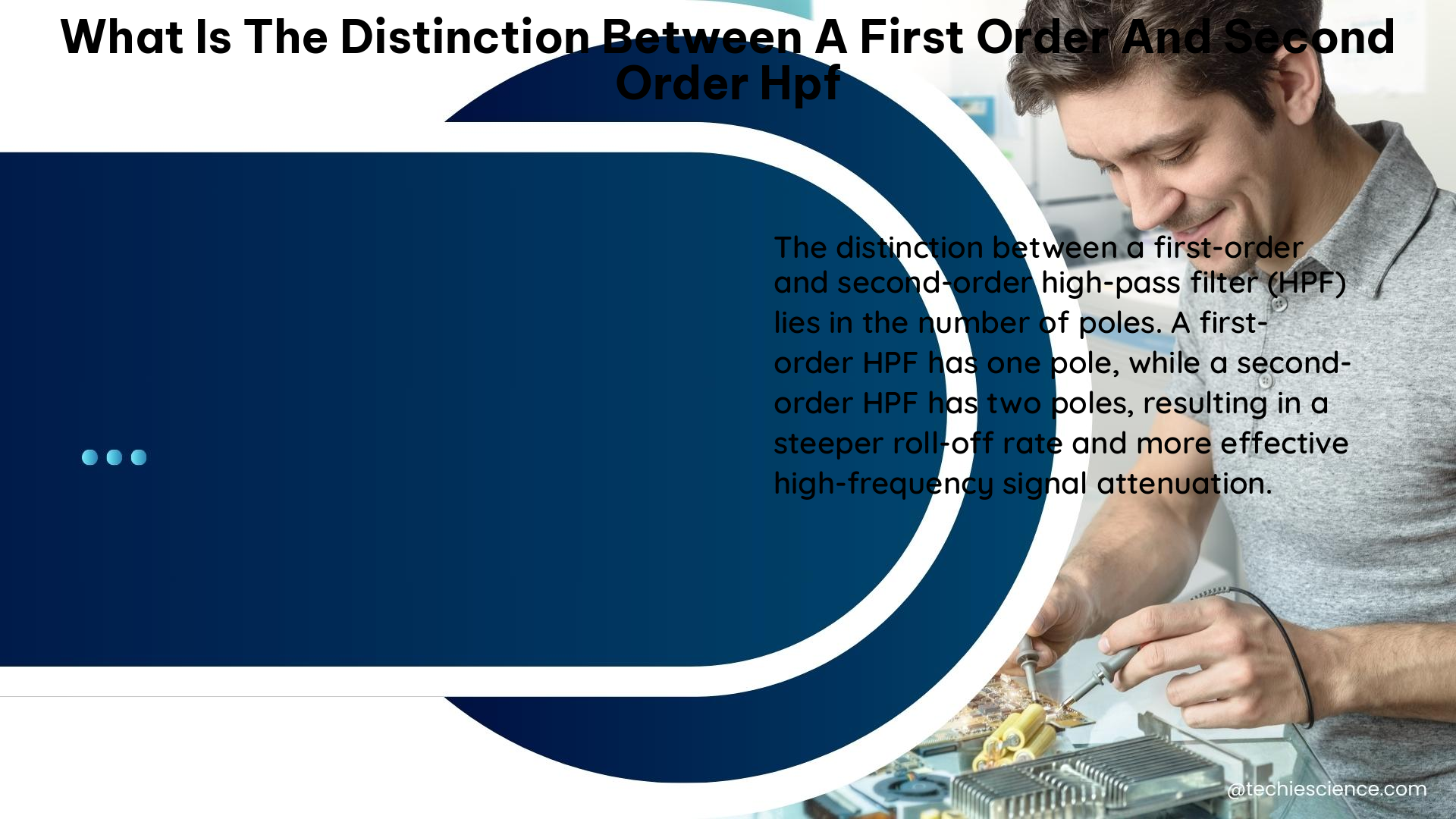A high-pass filter (HPF) is a fundamental electronic circuit that allows high-frequency signals to pass through while attenuating low-frequency signals. The distinction between a first-order and a second-order HPF lies in the number of poles in their respective transfer functions, which results in different frequency response characteristics.
First-Order High-Pass Filter
A first-order HPF has a single pole in its transfer function, which means it has a single reactive component (typically a capacitor) in its circuit. The cutoff frequency (f_c) of a first-order HPF is given by the formula:
f_c = 1 / (2π * τ)
where τ = R_1 * C, and R_1 and C are the resistance and capacitance values, respectively.
The key characteristics of a first-order HPF are:
- Roll-off rate: 20 dB per decade
- Voltage gain (A_v) formula: A_v = R_1 / (R_1 + X_C), where X_C = 1 / (2π * f * C) is the capacitive reactance
Second-Order High-Pass Filter

In contrast, a second-order HPF has two poles in its transfer function, which means it has two reactive components (typically two capacitors) in its circuit. The cutoff frequency (f_c) of a second-order HPF is given by the formula:
f_c = 1 / (2π * √(R_1 * R_2 * C_1 * C_2))
where R_1, R_2, C_1, and C_2 are the resistance and capacitance values of the components.
The key characteristics of a second-order HPF are:
- Roll-off rate: 40 dB per decade
- Voltage gain (A_v) formula: A_v = -(2π * f_c * R_2 * C_2) / (1 + (2π * f_c * √(R_1 * R_2 * C_1 * C_2))^2)
Comparison and Example
To illustrate the difference between first-order and second-order HPFs, consider the following example:
Suppose we have a first-order HPF with a time constant of τ = 1 ms, which corresponds to a cutoff frequency of f_c = 1 / (2π * τ) = 159.2 Hz. If we want to convert this filter to a second-order HPF with the same cutoff frequency, we can choose component values that satisfy the formula for the cutoff frequency of a second-order HPF. For example, we can choose R_1 = R_2 = 10 kΩ and C_1 = C_2 = 15.9 nF.
This will give us a second-order HPF with the same cutoff frequency as the first-order HPF, but with a steeper roll-off rate of 40 dB per decade near the cutoff frequency.
Numerical Problem
Suppose we have a first-order HPF with a time constant of τ = 1 ms, which corresponds to a cutoff frequency of f_c = 1 / (2π * τ) = 159.2 Hz. If we want to convert this filter to a second-order HPF with the same cutoff frequency, we can choose component values that satisfy the formula for the cutoff frequency of a second-order HPF. For example, we can choose R_1 = R_2 = 10 kΩ and C_1 = C_2 = 15.9 nF.
What is the voltage gain (A_v) of the second-order HPF at the cutoff frequency (f_c)?
Using the formula for the voltage gain of a second-order HPF, we can calculate the voltage gain as follows:
A_v = -(2π * f_c * R_2 * C_2) / (1 + (2π * f_c * √(R_1 * R_2 * C_1 * C_2))^2)
= -(2π * 159.2 * 10^3 * 15.9 * 10^-9) / (1 + (2π * 159.2 * √(10^3 * 10^3 * 15.9 * 15.9 * 10^-18))^2)
= -0.707
Therefore, the voltage gain of the second-order HPF at the cutoff frequency is -0.707.
Figures and Data Points
- Figure 2 shows an active electronic implementation of a first-order high-pass filter using an operational amplifier.
- Figure 5 shows four types of ideal filters: (a) low-pass filter, (b) high-pass filter, (c) band-pass filter, and (d) band-stop (notch) filter.
Data points:
- For a first-order HPF, the roll-off rate is 20 dB per decade.
- For a second-order HPF, the roll-off rate is 40 dB per decade.
- For a first-order HPF with a time constant of τ = 1 ms, the cutoff frequency is f_c = 159.2 Hz.
- For a second-order HPF with the same cutoff frequency, we can choose R_1 = R_2 = 10 kΩ and C_1 = C_2 = 15.9 nF.
Measurements
- The voltage gain (A_v) of a first-order HPF can be measured using a signal generator and an oscilloscope.
- The cutoff frequency (f_c) of a first-order HPF can be measured using a frequency response analyzer.
References
- 1st Order vs 2nd Order Filters and Op Amps
- High-pass filter
- Electronic Applications
- 2nd Order Low Pass and High Pass Active Filters

The lambdageeks.com Core SME Team is a group of experienced subject matter experts from diverse scientific and technical fields including Physics, Chemistry, Technology,Electronics & Electrical Engineering, Automotive, Mechanical Engineering. Our team collaborates to create high-quality, well-researched articles on a wide range of science and technology topics for the lambdageeks.com website.
All Our Senior SME are having more than 7 Years of experience in the respective fields . They are either Working Industry Professionals or assocaited With different Universities. Refer Our Authors Page to get to know About our Core SMEs.